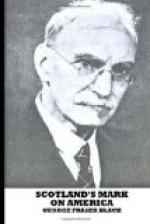James Blair (1656-1743), born in Edinburgh, was the chief founder and first President of William and Mary College, and Mungo Inglis was the first Grammar Master there till 1712. Francis Alison (1705-99), an Ulster Scot educated in Glasgow, was Vice-Provost of the College of Philadelphia, now the University of Pennsylvania. David Rhind, tutor of John Rutledge, “an excellent classical scholar, and one of the most successful of the early instructors of youth in Carolina,” was of Scottish birth. The tutor of Thomas Jefferson was also a Scot. Samuel Finley (1715-66), born in Armagh of Scots ancestry, S.T.D. of Glasgow University, 1763, was President of the College of New Jersey, and one of the ancestors of Samuel Finley Breese Morse, inventor of the Morse system of telegraphy. In educational work in the eighteenth century no name stands higher than that of William Smith (1727-1803), born in Aberdeen, first Provost of the College of Philadelphia. He was the introducer of the system of class records now used in all American universities. Isabella Graham (1742-1814), born in Lanarkshire, ranked as one of the most successful teachers in New York at the end of the eighteenth century. James Dunlap (1744-1818), of Scottish descent, was President of Jefferson College, Pennsylvania. William Graham (1745-99), was first President of Washington College (now Washington and Lee University). Robert Patterson (1743-1824), a Scot of Ulster, was Vice-Provost of the University of Pennsylvania (1810-13), and Director of the United States Mint in Philadelphia (1805-24). His son, Robert M. Patterson, succeeded him as Vice-Provost in 1828. Peter Wilson (1746-1825), born at Ordiquhill, Aberdeenshire, published several important text-books on Latin and Greek, was Member of the New Jersey Legislature in 1777, and in 1783 was appointed to revise and codify the laws of the state of New York. Thomas Craighead (1750-1825), first President of Davidson Academy (1785-1809), afterwards the University of Nashville, was great-grandson of Rev. Robert Craighead who went from Scotland to Donoghmore in Ireland. Joseph McKeen (1757-1807),




